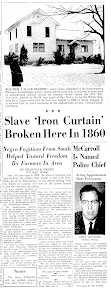Jacob Aumack (1821 – 1917), a farmer of Eau Claire, Michigan was my husband Reg’s great, great grandfather. It turns out that Jacob possibly had another role besides farmer.
I found the following news item in the News-Palladium of Benton Harbour Michigan, dated December 31, 1959 which mentions Jacob Aumack.
| From Aumack in the Michigan newspapers |
Conductor on Underground Railroad
It appears Jacob had a very courageous and dangerous role as a conductor on the Underground Railroad.
The Underground Railroad was an informal network of secret routes and safe houses used by 19th-century black slaves in the United States to escape to free states and Canada with the aid of abolitionists and allies who were sympathetic to their cause. The term is also applied to the abolitionists, both black and white, free and enslaved, who aided the fugitives. Other various routes led to Mexico or overseas. Created in the early 19th century, the Underground Railroad was at its height between 1850 and 1860. One estimate suggests that by 1850, 100,000 slaves had escaped via the “Railroad”. British North America, where slavery was prohibited, was a popular destination, as its long border gave many points of access. More than 30,000 people were said to have escaped there via the network at its peak, although US Census figures account for only 6,000. The Underground Railroad fugitives’ stories are documented in the Underground Railroad Records.
The caption on the photo of the house reads:
“WAS THIS A SLAVE STATION?: Amos Green, president of the Southwestern Michigan Archeological society stands before farm that is believed to have been an underground railroad station for runaway slaves before the Civil War. The farm, located on M-140 just south of Eau Claire is now the Walter Sommers farm. Papers show that the farm was bought in 1855 by Jacob Aumack. It is believed that he was a conductor in the underground system.”
The Headline of the article reads: “Slave Iron Curtain’ Broken Here In 1860 Negro Fugitives From South Helped Toward Freedom By Farmer”
Excerpted from the article:
“A station was any home that would hide slaves for a short time. Persons helping the slaves were called conductors. Jacob Aumack was a conductor and operated a station on the underground railroad north of Eau Claire near M-140, according to information unearthed by Green.”
Continued on page 15 mid-page, mention of Jacob Aumack:
“That Jacob Aumack operated a station and was a conductor on the underground railroad is well established by his grandchildren and a son-in-law.”
“Miss Reva Runnels, daughter of Mrs. Emma Aumack Runnels, recalls her mother telling her the following: Emma and her mother were at home alone one night when a knock came at the door. When Mrs. Aumack opened the door, a very large runaway slave stood outside. The size and appearance of the slave frightened Emma so much she remembered it clearly through all her life”.
“The slaves always came at night. Sometimes a white man would be with them. They would rap on the door and when the door was opened, there would be no one outside.
“Aumack would say, “You are among friends,” and the slaves would come from where they were hiding.
“They were then given food and clothing and be hidden until it was safe to take them to the next station.
“The late Henry Tibbs said that Aumack worked for William Smythe Farmer with whom he had come to Michigan in 1848. Occasionally Aumack would stop work and say, “I have to go to Dowagiac, and would not be at work the next day. It was always all right with Farmer, no matter how busy they were.
“Two other grandchildren of Jacob Auamck, Jolly Tibbs, son of Mrs. Elizabeth Aumack Tibbs and Ferris Aumack, son of Jake Aumack, recall their father Jacob Auamck, hiding run away slaves and conducting them to the next station.
“On several occasions an effort was made to secure information from the the late Henry Tibbs, knowing that his first wife was Elizabeth Aumack. One day while an incident was being related to him about runaway slaves, Tibbs interrupted with, “They used to help them through here.”
“Who helped them?” he was asked.
“Jacob Aumack helped a lot of them,” he replied.
Nothing further could be learned.
“This underground railroad station, located by Miss Runnels, was on what now is the Walter Tabor farm at Eau Claire, Green reports. It is believed that he also operated the station after he moved to what is now the Walter Sommers place on M-140 north of Eau Claire which he bought in 1855.”
The article goes on to discuss the location of another station in a cabin near Mud Lake and gives further details about how the slaves were hidden. The article concludes with this statement.
“these things were whispered about, but never discussed, for hiding slaves was illegal.”
This is an incredible story of Jacob Aumack, our children’s ggg-grandfather and the courage he displayed to help the slaves escape to freedom.
Stories like this are why I do genealogy!
Other items to note in this article:
- photo of Jacob Aumack home purchased in 1855
- Jacob Aumack came to Michigan in 1848 with William Smythe Farmer (As an aside – Jacob named one of his children Smythe. We also have a copy of the platte map showing the William Smythe Farmer farm was situated next door to Jacob Aumack’s farm.)
- Names of some of his descendants
SOURCE:
Newpaper: News-Palladium, The
Publication Date: Thursday, December 31, 1959, pages 1, 15.
Newspaper Location: Benton Harbor, Michigan, United States Of America
Advanced search for Jacob Aumack, USA, Michigan
Accessed on Ancestry.com April 10, 2011
—
Updated: Found a good story and maps of the the Underground Railroad on the Shelby History webpage.
